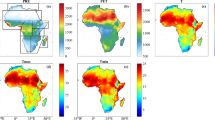Abstract
The purpose of this research is to investigate near surface mesoscale equivalent temperatures (TE) in Kentucky (located in east central USA) and potential land cover influences. TE is a measure of the moist enthalpy composed of the dry bulb temperature, T, and absolute humidity. Kentucky presents a unique opportunity to perform a study of this kind because of the observational infrastructure provided by the Kentucky Mesonet (www.kymesonet.org). This network maintains 69 research-grade, in-situ weather and climate observing stations across the Commonwealth. Equivalent temperatures were calculated utilizing high-quality observations from 33 of these stations. In addition, the Kentucky Mesonet offers higher spatial and temporal resolution than previous research on this topic. As expected, the differences (TE − T) were greatest in the summer (smallest in the winter), with an average of 35 °C (5 °C). In general, the differences were found to be the largest in the western climate division. This is attributed to agricultural land use and poorly drained land. These differences are smaller during periods of drought, signifying less influence of moisture.







Similar content being viewed by others
References
Bolton D (1980) The computation of equivalent potential temperature. Mon Weather Rev 108:1046–1053
Davey CA, Pielke RA Sr, Gallo KP (2006) Differences between nearsurface equivalent temperature and temperature trends for the eastern United States: equivalent temperature as an alternative measure of heat content. Glob Planet Chang 54:19–32
Fall S, Diffenbaugh NS, Niyogi D, Pielke RA Sr, Rochon G (2010) Temperature and equivalent temperature over the United States (1979-2005). Int J Climatol 30:2045–2054
Hoerling M, Eischeid J, Kumar A, Leung R, Mariotti K, Mo K, Schubert S, Seager R (2014) Causes and predictability of the 2012 Great Plains drought. Bull Amer Meteorol Soc 95:269–282
IPCC (2013) Climate change 2013: the physical science basis. Cambridge University Press 1535 pp
Jin S, Yang L, Danielson P, Homer C, Fry J, Xian G (2013) A comprehensive change detection method for updating the National Land Cover Database to circa 2011. Remote Sens Environ 132:159–175
KGN (Kentucky Geography Network) (2012) Kentucky statewide 1 meter aerial imagery. Frankfort, KY: KGN. Retrieved April 14, 2014, From http://kygisserver.ky.gov/geoportal/catalog/ search/resource/details.page?uuid=%7BAEEB6F93-CB84-4C06-904C-F4B69079B493%7D
Mahmood R, Foster SA, Logan D (2006) The GeoProfile metadata, exposure of instruments, and measurement bias in climatic record revisited. Int J Climatol 26:1091–1124
Mahmood R, Pielke RA Sr, Hubbard KG, Niyogi D, Bonan G, Lawrence P, McNider R, McAlpine C, Etter A, Gameda S, Qian B, Carleton A, Beltran-Przekurat A, Chase T, Quintanar AI, Adegoke JO, Vezhapparambu S, Conner G, Asefi S, Sertel E, Legates DR, Wu Y, Hale R, Frauenfeld ON, Watts A, Shepherd M, Mitra C, Anantharaj VG, Fall S, Lund R, Nordfelt A, Blanken P, Du J, Chang H-I, Leeper R, Nair US, Dobler S, Deo R, Syktus J (2010) Impacts of land use land cover change on climate and future research priorities. Bull Am Meteorol Soc 91:37–46
Mahmood R, Pielke RA Sr, Hubbard KG, Niyogi D, Dirmeyer PA, McAlpine C, Carleton AM, Hale R, Gameda S, Beltran-Przekurat A, Baker B, McNider R, Legates DR, Shepherd M, Du J, Blanken PD, Frauenfeld OW, Nair US, Fall S (2014) Land cover changes and their biogeophysical effects on climate. Int J Climatol 34:929–953
MRCC (Midwest Regional Climate Center) (2014) State and climate division data—monthly by year. Urbana-Champaign: MDCC. Retrieved September 18, 2014, from http://mrcc.isws.illinois.edu/CLIMATE/nClimDiv/STCD_monthly1.jsp
NCDC (National Climatic Data Center) (2013) US palmer drought indices. Asheville: NCDC. Retrieved September 18, 2014, from http://www.ncdc.noaa.gov/oa/climate/research/prelim/drought/palmer.html
NCDC (National Climatic Data Center) (2015) US climate divisions. Asheville: NCDC. Retrieved March 6, 2015, from http://www.ncdc.noaa.gov/monitoring-references/maps/us-climate-divisions.php
NRC (National Research Council) (2005) Radiative forcing of climate change: expanding the concept and addressing uncertainties. The National Academies Press, Washington D.C.
Peterson TC, Willett KM, Throne PM (2011) Observed changes in surface atmospheric energy over land. Geophys Res Lett 38:L16707. https://doi.org/10.1029/2011GL048442
Pielke RA Sr (2001) Influence of the spatial distribution of vegetation and soils on the prediction of cumulus convective rainfall. Rev Geophys 39:151–177
Pielke RA Sr, Davey C, Morgan J (2004) Assessing “global warming” with surface heat content. Eos Trans 85:210–211
Pielke RA, Pitman A, Niyogi D, Mahmood R, McAlpine C, Hossain F, Klein Goldewijk K, Nair U, Betts R, Fall S, Reichstein M, Kabat P, de Noblet-Ducoudr’e N (2011) Land use/land cover changes and climate: modeling analysis and observational evidence. WIREs Clim Change 2:828–850
Rogers JC, Wang S, Coleman JSM (2007) Evaluation of a long term (1882-2005) equivalent temperature time series. J Clim 20:4476–4485
Schoof JT, Heern ZA, Therrell MD, Jemo JWF (2014) Assessing trends in lower tropospheric heat content in the Central USA using equivalent temperature. Int J Climatol 35:2828–2836
USDM (United States Drought Monitor) (2012) Drought monitor map archive. USDM, Lincoln Retrieved August 25, 2014, from http://droughtmonitor.unl.edu/MapsAndData/MapArchive.aspx
Acknowledgements
This research is funded by the WKU Graduate Student Research Fellowship. The authors would like to thank Dr. Eric Rappin, William Rodgers, and Dolly Na-Yemeh for technical assistance.
Author information
Authors and Affiliations
Corresponding author
Rights and permissions
About this article
Cite this article
Younger, K., Mahmood, R., Goodrich, G. et al. Mesoscale surface equivalent temperature (TE) for East Central USA. Theor Appl Climatol 136, 65–75 (2019). https://doi.org/10.1007/s00704-018-2468-7
Received:
Accepted:
Published:
Issue Date:
DOI: https://doi.org/10.1007/s00704-018-2468-7




